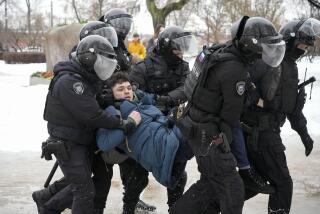Prisoners of Legacy of Repression
NORILSK, Russia — They came in rags and shackles into icebound desolation, condemned prisoners packed onto Yenisey River barges among the tools they would use to cut through frozen wilderness and tap the north’s natural riches.
A tin-roofed shrine marks the blackened tundra where thousands died building this most notorious of labor camps in the 1930s. The more breathtaking monument, though, is the smoke-belching city of 300,000 left behind by those victims of “the Terror.”
Never envisioned as a venue for human survival, Norilsk has, nevertheless, persevered through six decades of oppression to become part of the provincial industrial backbone of the Russian economy and one of the milestones for measuring the reach of the new capitalist revolution.
As Russians rebuild after a failed Communist experiment that lasted 74 years, life in bustling cities such as Moscow and St. Petersburg has become undeniably better for most working people. But in the provincial havens of the proletariat where the majority of Russia’s 148 million citizens live, many remain bound by a legacy of repression that crushes initiative, lowers expectations and reinforces the ancient Russian work ethic of master and slave.
From the woodcutters of Karelia on the Finnish border to the fishermen and traders of Vladivostok on the Pacific coast, Russians in the far-flung regions find themselves held back from the rewards of democracy and a market economy as much by fears of an unscripted future as by the barriers to opportunity surviving from the past.
Nostalgia is strong in Norilsk for the bare essentials of survival that Communist planners provided workers in an era when no one was accountable for the bottom line. When money had little real buying power, no price was too high to pay to develop the extremes of the Soviet empire in the state’s reckless pursuit of industrial glory. Store shelves were as empty here as elsewhere in that age of perpetual shortage, but everyone existed in a single stratum of spartan equality.
But six years after scrapping communism, provincial Russians have been divided into economic castes--abject poverty for the laboring masses in natural resource centers like this, fabulous wealth for the aggressively avaricious holding sway in company towns and a slim but expanding entrepreneurial class in booming cities like those along the Volga River.
In Norilsk, nearly 2,000 miles from Moscow, Communist Party bureaucrats have given way to a new clique of brazen industrialists who reign over the $660-million Norilsk Nickel complex and its huge metal reserves as if they were personal treasure.
Repository of Abused, Desperate
Under the yoke of the industrialists, workers find little to celebrate in the historic change of economic systems.
“Our lives are no different from those of the prisoners who built this place,” sighs Larissa Didus, 27, a laborer at the Hope copper-smelting factory. “We have no way out. No one else wants us, so we will have to work here for the rest of our lives. Every single one of us would leave if we had the chance.”
Her despondency is echoed throughout this Arctic Circle eyesore’s blue-collar ranks, to whom the concepts of ambition and positive thinking are as alien as palm trees.
So far impervious to the freedoms and reforms that have made inroads elsewhere in Russia, Norilsk remains a repository of the abused and the desperate. Bitter winters and savage pollution are as inescapable for today’s cash-strapped residents as they were for the prisoners bound to this hostile territory by iron chains.
Yet, even here, where Moscow bankers have gained control of Norilsk Nickel’s assets through one of the most dubious privatization schemes of the Russian government, pressures for humanitarian relief are being brought to bear.
A federal program to relocate retired and laid-off workers from the northern extremes promises to move 1.2 million people to more hospitable territory over the next decade, including about 80,000 from Norilsk, says Vladimir Kuramin, chairman of the federal Committee on Development of the North.
The depopulation plan is a $9-billion federal effort to relocate those marooned here by economic chaos, like the hyper-inflation and pyramid schemes of the early 1990s that robbed most Russians of their life savings.
Many See No Way Out
Anna Surovtseva is typical of millions of elderly Russians whose ruble savings became worthless overnight. Now 72 and living on a pension of about $86 a month, the retired Norilsk Nickel clerk has no reason to stay but no means to go elsewhere. An air ticket to anywhere costs upward of $200.
“There’s no semblance of life here,” says the great-grandmother who fled here to escape a broken marriage and child-custody battle and has reluctantly made her home in Norilsk for 17 years. “During the polar night, there is only blackness for nearly three months, and it wears on one’s soul.”
Unlike most stranded pensioners, Surovtseva owns another apartment--in the city of Nikolayeva in balmy Ukraine. She would be happy to return there. But as a citizen of Russia since the 1991 collapse of the Soviet Union, she has no right to sell Ukrainian property and would lose most of her Russian pension should she “emigrate” from Russia to what is now a foreign country.
“Even if I could save enough to buy an air ticket out of here, I couldn’t survive in Ukraine on less money, and I doubt, at my age, I could find any work,” says the widow stuck in two tiny rooms of a reeking tenement.
Living out one’s days in Norilsk would be difficult for any Westerner to imagine. Clouds of soot from the smelters mix with snow to shroud the terrain in a thick layer of gritty black slime that sticks to pedestrians’ clothing and the fur of pets. A three-month polar night is the dark heart of a 10-month winter that eases only in July and August, when a smoggy haze from the melting permafrost breeds unbearable humidity and giant mosquitoes.
There are no roads or rails connecting Norilsk to the Russian “mainland,” as the territory beyond the uncharted tundra is known. Metals go by barge down the Yenisey to Central Russia for shipment onward to markets. The airport is the only way out for people, and weather closes even that escape route at least 50 days of the year, says Norilsk Mayor Vasily Tkachev.
Norilsk lost its status as a penal colony after dictator Josef Stalin’s death in 1953. But its evolution into a city remained a study in coercion. Temporary work brigades of the Komsomol youth movement at first took the place of conscripts. Then the Soviet system of “distribution” dispatched young college graduates here for three-year terms to pay back the state for their education.
Wages were high and benefits plentiful during the boom years of the 1970s and 1980s, when the state devoted huge sums to support Norilsk because its metals could be traded for consumer goods within the Communist bloc’s closed markets. Some workers married and stayed up to 15 years, after which the state would relocate them as part of an early retirement package.
In the bracing atmosphere of fledgling capitalism, workers are now usually expected to finance their own exit.
But as each reduction in the work force at Norilsk Nickel has added to the ranks of the idle and impoverished, managers of the omnipotent enterprise have had to begin building housing in more habitable regions for some of those they have laid off. The company has dropped to 121,000 employees from 135,000 in the Soviet era and hopes to slim down by the end of the century to 85,000 to cut costs and maximize efficiency. The first resettlements at company expense are expected next year, says Alexander Chulkov, the enterprise’s personnel director.
While the managers eagerly support relocation plans, most resist an accompanying federal proposal for reducing the population here by switching to the “shift system” that prevails in Russia’s oil and gas regions.
In equally harsh territories such as Tyumen and Khanty-Mansiysk, workers commute between the remote resource sites from more livable cities, sleeping in crude barracks while on two-week work shifts, then flying home to their families for two weeks off.
“Oil and gas operations usually involve only a few hundred workers at each site. Here in Norilsk, we would be talking about tens of thousands. It’s just not suitable to shift work,” says Marina Govorova, director of the Sociological Research Center that remains a loyal subsidiary of Norilsk Nickel.
But federal officials trying to balance lifestyle concerns with the need to maintain vital industries in the provinces disagree. “This is clearly the way of the future,” says Kuramin, of the northern development committee. “The enterprises are resisting it now because it will cost money at the outset, but they will eventually realize that it’s much more cost-effective not to have to maintain a whole social network in severe conditions.”
The federal government, however, is regarded by most provincial Russians more as a crony than a watchdog of industrialist bosses.
Bettering the Bottom Line
Norilsk Nickel was one of dozens of valuable state-owned enterprises mortgaged by Russian President Boris N. Yeltsin in 1995 when he needed cash to pay wages and pensions while he sought reelection.
Russia’s leadership used attractive state assets like Norilsk Nickel as collateral on loans from private banks. When the government defaulted, the financiers of Moscow’s Uneximbank, for example, won control of Norilsk Nickel and now seem more interested in short-term profit than in investing for the future.
Indeed, the pressure on them to better the bottom line has already encouraged the bankers to divest Norilsk Nickel of responsibility for such services as municipal heating and higher education. Once master of every function, from the movie theater to the graveyard, Norilsk Nickel has been slowly spinning off nonindustrial duties to private entrepreneurs and resistant local officials.
“We want these matters of supply to be someone else’s problems, but unfortunately, unless we take care of it ourselves, it doesn’t get taken care of at all,” complains Lev Kuznetsov, one of the new deputy directors of Norilsk Nickel deployed here by Uneximbank.
Mayor Tkachev confirms that the federal government has been slow to provide any money to maintain the public works that were once on the budget of Norilsk Nickel.
More Layoffs Planned
Spurred by deteriorating social conditions and the need to operate more efficiently, Norilsk Nickel is seeking to shed 16,000 workers this year, which would mean relocating about 45,000 when family members are included.
Kuznetsov estimates that it will cost the enterprise $10,000 for each person in moving and severance expenses--a sum he says neither the bank nor the company can afford.
Norilsk Nickel, though commanding as much as 20% of the world markets for its metals, inherited nearly $2 billion in wage, energy and tax debts racked up under state management. That bill--mostly owed to government-owned subsidiaries--remains unpaid and offers a handy shield for fending off federal demands that the enterprise pick up a bigger share of social costs.
Relocation programs are aimed at pensioners and those laid off from the downsizing Norilsk Nickel. But the quest to move up and out is not limited to such individuals. Even students at special schools designed to prepare the next generation of technicians have their eye on careers that will deliver them out of the tundra.
“My parents are saving to send me to college in St. Petersburg so that they will have somewhere else to go to in the future,” says Sergei Afanasiev, 16. “This is not an environment anyone can live in.”
Virtually no one speaks seriously of trying to clean up Norilsk’s ecological mess. As head of the Regional Committee for the Defense of Nature, Vitaly Savchenko is supposed to monitor such conditions. But he lacks the money or enforcement power to put real obstacles in the path of polluters.
He brandishes a chilling catalog of human consequences of industry’s destruction--studies by the enterprise’s own research branches showing a doubling of infant mortality over the last four years to 17 per 1,000 and nearly as sharp a rise in the death rate.
“Before, it was assumed everyone would eventually leave for warmer climates, so no attention was paid to the environmental disaster that was being created here,” Savchenko says. “But as people are forced to stay by economic factors, the consequences are becoming alarmingly clear.”
Norilsk’s 1,000-bed hospital is crammed with the casualties of industry’s indifference to nature: wards full of patients with respiratory ailments, heart problems and cancers.
“Every person in Norilsk spends his working years dreaming of getting out of here,” says chief cardiologist Viktor Bugrov, himself a native of Odessa and nostalgic for the sunny south.
To sacrifice a few years to build a nest egg is agreeable to most young families but not a lifetime condemned to the suffocating squalor. “We thought we would be here for just a few years, to get our careers started and save a little for the future,” says Vera Kalugina, 38, an engineer who came here with her husband nearly two decades ago.
She sends her 14-year-old daughter off to her mother’s country house near Yekaterinburg each summer to escape the pollution. The rest of the year she plots how the family budget can be stretched to pay for an education elsewhere.
“She’s a good student and will succeed in the new business environment on the mainland,” Kalugina says proudly. “We never expected to still be here, but fate has delivered some cruel surprises. But if the next generation has more opportunities, we can consider our own difficulties a sacrifice worth making.”
NEXT: In the steel town of Cherepovets, residents must dig deep to deal with the new, post-Soviet demands for self-sufficiency, initiative and decisiveness.
More to Read
Sign up for Essential California
The most important California stories and recommendations in your inbox every morning.
You may occasionally receive promotional content from the Los Angeles Times.











